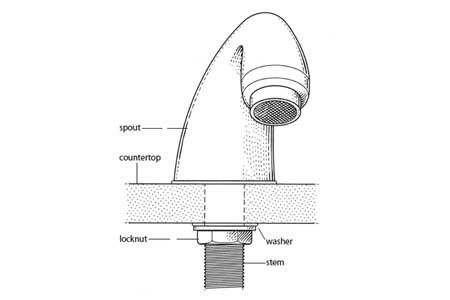Anytime you replace an old faucet, you must remove the locking nut that secures the faucet to the countertop. That nut may be difficult to remove due to corrosion or mineral buildup from years of water seepage. Here are a few tricks to loosen stuck faucet nuts, some simple and others more aggressive.
Basic Techniques for Loosening a Stuck Nut
Usually, you’ll only need a simple solution to loosen the nut. We recommend trying each technique in the order listed.
Tighten the Nut
The first step to loosen a stuck nut is to try tightening it slightly with the correct size wrench. This technique might seem counterproductive, but tightening it first can loosen some of the buildup. Add a cheater pipe or breaker bar as necessary to extend your wrench’s length and add more leverage. If you can tighten the nut, then try loosening it.
Use a Hammer
Sometimes, a little shock can get the nut moving. Place a center punch on the nut, then strike the punch with a hammer. This ensures you hit the nut itself and not the surrounding threads.
Use Heat To Expand the Metal
Heat causes metal to expand slightly, which may be enough to break the nut free. You can add heat safely with a hair dryer or heat gun. If you’re using an open flame, such as a propane torch, be extremely cautious and shield anything flammable with a flame-resistant fabric. Try turning the nut with your wrench before it cools.
Apply Penetrating Oil
Finally, try using a penetrating oil such as Liquid Wrench on the threads.
Use a wire brush to wipe orange streaks or crumbly bits of rust off the area. Squirt the oil on the threads, and let it soak for about 15 minutes before trying to turn the nut. Particularly stubborn nuts could loosen with a few applications over 24 hours.
If the nut has whitish lime deposits, remove what you can with a wire brush, then brush on white vinegar to dissolve what remains.
Advanced Techniques for Stubborn Nuts
When shock, heat, and oil don’t work, you can try one of these methods as a last resort. Be careful, as they can potentially damage the components surrounding the nut.
Using a Nut Splitter
Nut splitters are specialized tools designed to crack a stuck nut without damaging the bolt threads. To use one, place it over the stuck nut and tighten the screw until it touches the nut. When you keep tightening the screw, it’ll apply pressure to the nut and eventually cause it to crack. You can then remove the nut with pliers.
Cutting the Nut Off
If nothing else works, you may need to cut the nut off with a hacksaw or reciprocating saw. This will destroy the nut and potentially damage the bolt.
Make a vertical cut through the threaded stem and nut. Don’t cut too deeply into the bolt itself to limit surrounding damage. Then, use a chisel or flathead screwdriver to pry the nut apart.
Preventing Nuts from Getting Stuck in the Future
Preventing nuts from becoming stuck is easier than dealing with them afterward. Here are some tips to save yourself time and frustration in the future:
- Apply a little plumber’s grease or anti-seize lubricant to the threads before you install a faucet nut, especially in areas prone to moisture or temperature fluctuations.
- Take care not to overtighten nuts.
- Use plumber’s tape on your new fixture’s threads to prevent mineral buildup and make future removal easier.
Our Conclusion
With the right approach and tools, you can loosen most stuck faucet nuts yourself. Start with simple methods such as penetrating oil and heat before progressing to more aggressive techniques. Remember to prioritize safety, especially when using heat or power tools. Finally, when you install your new faucet, use preventive measures to avoid stuck nuts in the future.

